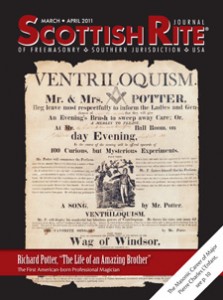Bro. Richard Potter: “The Great Magician”Posted in Articles, History, Media Archive, United States on 2014-10-04 23:04Z by Steven |
Bro. Richard Potter: “The Great Magician”
Scottish Rite Journal
The Scottish Rite of Freemasonry
Supreme Council, 33°
Washington, D.C.
Southern Jurisdiction, U.S.A.
March-April 2011
Elliott Saxton, 32°
Bro. Richard Potter [see also here] was the first professional American-born magician and is also credited with being our first successful ventriloquist. His fame was such that the town of Potter Place, New Hampshire, still carries his name. His tricks included dipping his hands into molten lead, crawling through solid logs, and causing men’s hats to speak. Perhaps one of his most famous feats was dancing on a pile of eggs without cracking a single shell.
In November 1811, he joined African Lodge No. 459 of Boston under the premier Grand Lodge of England (Moderns). Richard Potter is named in the June 18, 1827, “Declaration of Independence” of African Lodge as one of three Royal Arch Masons to whom the three signing Past Masters of the lodge delivered the “Grand Charter.” This is the document that created Prince Hall Masonry…
…Richard Potter was born in 1783 in Hopkinton, Massachusetts, and his mother was a slave named Dinah owned by Sir Charles Frankland, a pre-Boston-Tea-Party tax collector of the Port of Boston. Richard Potter’s paternity was never established, but he was raised by Sir Charles. It is thought that Potter’s father was Frankland’s son.
At the age of ten, he traveled to Britain as a cabin boy with a friend of the family, Captain Skinner. While in England, he decided that a life at sea was not for him and went on his own. He supposedly saw John Rannie, a magician and ventriloquist, perform at an English fair, and soon thereafter he began touring Britain and Europe with Rannie as his assistant. About 1800 Rannie and Potter came to the United States and joined a travelling circus…
…Because of his dark complexion, Potter was often thought to be an American Indian or Hindu, all of which added to his air of mystery. He was described in advertisements as a “Black Yankee”. He sometimes dressed in a turban and performed as an Asian or introduced his wife (accurately) as an American Indian. Potter took full advantage of his perceived exotic appearance and fueled the mystery over the origin of his birth by claiming to be the son of Benjamin Franklin. (Although Bro. Franklin was known to be quite the ladies’ man, he was out of the country at the time of Potter’s conception.)…
Read the entire article here.
